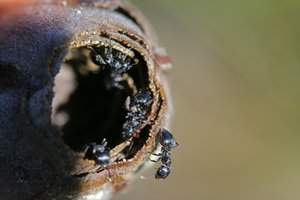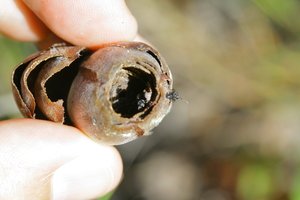Ants inside a King Protea
I was looking for signs of caterpillars on Proteas and found several flower buds of Protea cynaroides with holes like this one, I inspected two of them and found different species of ants. This was the first, larger one (for the other, smaller one I couldn't get useful photos). The ants were actually coming from the hollowed stem.
Other observations of Cocktail Ant (Crematogaster peringueyi)
Comments
Do you know...?
Do you know which caterpillars do that?
José R. Ferrer-Paris
Which
I think there are many caterpillars and grubs: butterflies, moths, beetles of several groups.
It is published somewhere: I can probably get it if you are interested.
Yes please.
Yes please.
-- Beetledude
Sorry: dont have access anymore:
This is the paper I remembered:
INSECTS - A HAZARD TO THE PROTEA INDUSTRY
Author: J.H. COETZEE
Abstract:
A crop which is cultivated in its natural habitat is attacked by a wide spectrum of insects. The insects on Proteaceae can be divided into three groups according to the damage they cause: (a) flower visitors, some of which cause serious phytosanitary problems (b) leaf feeders and leaf miners (c) borers, including both stem and seed borers. Natural fynbos which borders on cultivated proteas creates problems with the control of these pests since it serves as a source of re-infestation. To control this wide spectrum of pests an integrated pest control programme must be developed. Such a programme should include chemical and biological control, as well as correct cultivation methods. The use of insecticides should play a subordinate role. A thorough knowledge of the biology and ecology of the different pests and the effect of the pests on these plants are important requirements for this programme. Without an efficient pest control programme proteas cannot be cultivated successfully in their natural habitat.
Acta Horticulturae 185: I International Protea Research Symposium
http://www.actahort.org/members/showpdf?booknrarnr=185_22
My (paper) copy got filched ...
More at
More at http://rusticranch.com/articles/insects.html
In direct response to question above:-
"... The species which tunnel in the inflorescences and infructescences belong to the orders Coleoptera, Lepidoptera and Diptera. Their larvae cause the young inflorescence buds to become malformed and during the flowering stage florets are destroyed. The infructescences are also subjected to seed predation. The borers include Genuchus hottentottus, Sphenoptera spp., Euderes lineicollis, Cryptolechia ammopleura, Argyroploce sp., Tinea sp., Bostra conspicualis, Capys alphaeus and Resseliella proteae ..."
(Coetzee & Giliomee 1987 Phytophylactica 19: 1-6)
see also Kroon 1999
Thanks Tony, there are a couple of useful references in that page.
There is also a list of Lepidoptera species that feed on Protea in the catalogue by Kroon (Kroon, D.M. 1999 Lepidoptera of Southern Africa. Host-Plants & Other Associations. Lepidopterist's Society of Africa). According to him at least 33 genera of Lepidoptera feed on Sugarbushes, there is no indication whether they are leaf or flower eaters, but most observations are associated with references.
José R. Ferrer-Paris
Thanks, Tony, ...
With reference to the Coetzee paper:
I have been aware of this paper but have never seen it on paper or on computer screen. I shall have to request it via Interlibrary Loan. Should have done it long ago, actually.
-- Beetledude









The ants are using the stems
The ants are using the stems hollowed out by the caterpillars. The caterpillars are long gone...